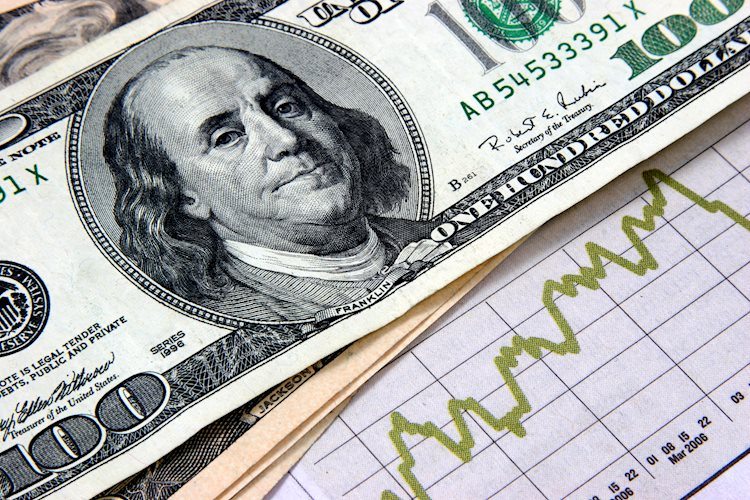US Dollar soars on back of robust PMI figures for June.
Markets continue to exercise caution as Fed officials maintain a wary stance on easing cycles.
Investors continue to leave the door open for a September cut.
On Friday, the US Dollar, benchmarked by the US Dollar Index (DXY), extended its gains, stemming primarily from robust Purchasing Managers Index (PMI) figures for June released by S&P.
Regarding the US economic outlook, there exist signs of some disinflation. Furthermore, Federal Reserve (Fed) officials’ cautious comments regarding embracing easing cycles serve to keep market expectations in balance. Should the mixed signals from the economy continue, these could potentially impede any further gains in the USD.
Daily digest market movers: US Dollar rides high on strong PMIs
US S&P Global Composite PMI for June rose slightly from 54.5 in May to a flash estimate of 54.6, indicating a healthy expansion in business activity within the private sector of the United States.
Similarly, the S&P Global Manufacturing PMI rose from 51.3 to 51.7 within the same time frame, while Services PMI witnessed an increase to 55.1 from 54.8 in May. This data beat the estimates done by analysts.
Probability of a rate cut as per CME Group’s FedWatch Tool continues to stand around 65% for the meeting on September 18.
DXY technical analysis: Bullish momentum continues, technicals pave the way for more upside
Technical indicators for Friday’s session demonstrated renewed bullish momentum backed by robust PMI figures. The Relative Strength Index (RSI) stood above 50, with the Moving Average Convergence Divergence (MACD) presenting green bars, pointing toward sustained bullish sentiment.
Additionally, the DXY Index maintains its footing above the 20-day, 100-day and 200-day Simple Moving Averages (SMAs). Coupled with the rising indicators, the US Dollar seems to be poised for additional gains.
Interest rates FAQs
Interest rates are charged by financial institutions on loans to borrowers and are paid as interest to savers and depositors. They are influenced by base lending rates, which are set by central banks in response to changes in the economy. Central banks normally have a mandate to ensure price stability, which in most cases means targeting a core inflation rate of around 2%. If inflation falls below target the central bank may cut base lending rates, with a view to stimulating lending and boosting the economy. If inflation rises substantially above 2% it normally results in the central bank raising base lending rates in an attempt to lower inflation.
Higher interest rates generally help strengthen a country’s currency as they make it a more attractive place for global investors to park their money.
Higher interest rates overall weigh on the price of Gold because they increase the opportunity cost of holding Gold instead of investing in an interest-bearing asset or placing cash in the bank. If interest rates are high that usually pushes up the price of the US Dollar (USD), and since Gold is priced in Dollars, this has the effect of lowering the price of Gold.
The Fed funds rate is the overnight rate at which US banks lend to each other. It is the oft-quoted headline rate set by the Federal Reserve at its FOMC meetings. It is set as a range, for example 4.75%-5.00%, though the upper limit (in that case 5.00%) is the quoted figure. Market expectations for future Fed funds rate are tracked by the CME FedWatch tool, which shapes how many financial markets behave in anticipation of future Federal Reserve monetary policy decisions.
Information on these pages contains forward-looking statements that involve risks and uncertainties. Markets and instruments profiled on this page are for informational purposes only and should not in any way come across as a recommendation to buy or sell in these assets. You should do your own thorough research before making any investment decisions. FXStreet does not in any way guarantee that this information is free from mistakes, errors, or material misstatements. It also does not guarantee that this information is of a timely nature. Investing in Open Markets involves a great deal of risk, including the loss of all or a portion of your investment, as well as emotional distress. All risks, losses and costs associated with investing, including total loss of principal, are your responsibility. The views and opinions expressed in this article are those of the authors and do not necessarily reflect the official policy or position of FXStreet nor its advertisers. The author will not be held responsible for information that is found at the end of links posted on this page.
If not otherwise explicitly mentioned in the body of the article, at the time of writing, the author has no position in any stock mentioned in this article and no business relationship with any company mentioned. The author has not received compensation for writing this article, other than from FXStreet.
FXStreet and the author do not provide personalized recommendations. The author makes no representations as to the accuracy, completeness, or suitability of this information. FXStreet and the author will not be liable for any errors, omissions or any losses, injuries or damages arising from this information and its display or use. Errors and omissions excepted.
The author and FXStreet are not registered investment advisors and nothing in this article is intended to be investment advice.
>>> Read full article>>>
Copyright for syndicated content belongs to the linked Source : FXStreet – https://www.fxstreet.com/news/us-dollar-strengthens-strong-sp-pmis-data-propels-rise-202406211744
